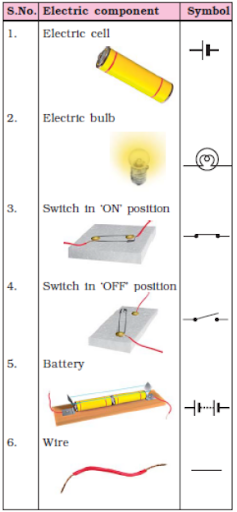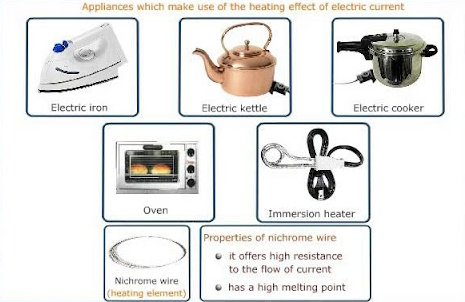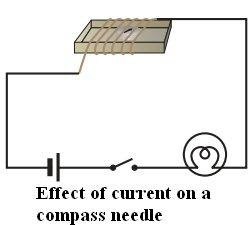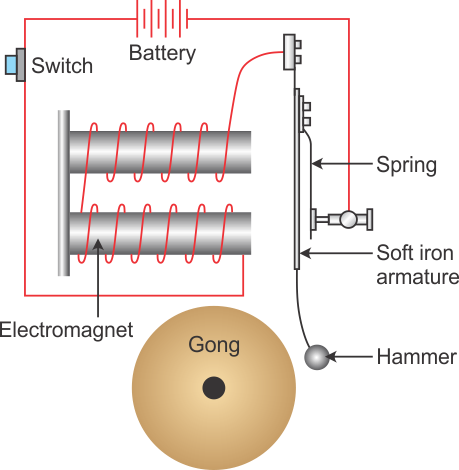ELECTRIC CURRENT AND ITS EFFECTS for Class 7 SCIENCE
Introduction
Hum sabhi jante hai ki electricity energy ka sabse convenient source hai kyonki yeh bahut saare electrical appliances ko run karne ke liye use ki jati hai. Electricity power stations mein produce hoti hai aur wires aur poles ke through hamare homes tak layi jati hai. Electric current ko bhi hum flow of electricity through conductor keh sakte hai. Ab hum iske baare mein hi padhenge.
Hamare chapter ka name hai "Electric current and its effects”, toh iss chapter mein hum electricity, electric current, electric circuit, uske components, etc. ke baare mein padhenge. Yaha hum janege ki electricity kya hoti hai aur yeh koun-koun se effects produce karti hai. Electric current ke magnetic aur heating effect ke baare mein hum detail mein padhenge aur iski kuchh applications ke baare mein bhi padhenge.
Symbols Of Electric Components
Hum kisi bhi electric circuit mein bahut saare electrical components use karte hai aur inko different symbols se denote kiya jata hai. Pehle hum inn electric components ke baare mein janege aur fir inke symbols dekhenge.
Electric cell: Electric cell ek device hota hai jo chemical energy ko electrical energy mein convert karta hai. Iske do terminals hote hai- positive aur negative. Iske symbol mein long aur short do parallel lines hoti hai, longer line positive terminal ko represent karti hai aur smaller line negative terminal ko represent karti hai.
Electric bulb: Electric bulb ek small aur simple light source hota hai.
Switch: Switch ek electrical device hai jo electric circuit mein electricity ke flow ko control karta hai.
Battery: Do ya do se jyada cells ke combination ko hum battery kehte hai.
Wire: Ek metal ka long thin piece jo electric current ko carry karta hai usko wire kehte hai.

Ab hum symbols ko use karke electric circuit banana sikhenge kyonki symbols ki help se electric circuit draw karna bahut easy hota hai. Electric circuit mein jab switch on position mein hota hai toh circuit complete hota hai aur current continuously flow karta hai. Jab switch off position mein hota hai toh circuit incomplete hota hai aur current flow nahi karta.

Bulb mein ek thin wire present hoti hai jisko hum filament kehte hai. Jab iss circuit mein current flow karta hai toh yeh filament glow karti hai aur agar yeh filament break ho jaye toh bulb glow nahi karta aur fuse ho jata hai.
Apne notice kiya hoga ki jab ek bulb bahut der se on hota hai toh woh hot ho jat hai, lekin yeh kaise hota hai?
Isko janne ke liye hum next topic padhenge.
Heating Effect Of Electric Current
Jab kisi electric wire ya electrical component mein electric current pass kiya jata hai toh woh current pass hone ki wajah se heat ho jata hai, isko hi hum heating effect of electric current kehte hai.
Jaisa ki hum bulb ke case mein bhi dekhte hai ki jab hum isko thodi der on rakhte hai toh yeh hot ho jata hai. Heating effect of electric current ko bahut saare electrical appliances mein use kiya jata hai. Eg- Electrical heater, electric iron, electric geyser, etc. sabhi appliances mein yeh hi effect use kiya jata hai. Inn sabhi appliances mein wire ki bani coil use ki jati hai jisko hum element kehte hai. Jab hum inko switch on karte hai toh iska element red hot ho jata hai aur heat give out karta hai.

Heating effects of electric current following factors par depend karta hai-
Electric Fuses
A safety device which works on the heating effect of current and prevents electric fires or damage to electrical appliances due to excessive flow of current is known as the fuse.
Iss safety device mein ek thin plated copper wire hoti hai jiski short length hoti hai, low melting point hota hai lekin iska resistance baki sari electric wiring se jyada hota hai. Isliye agar suddenly wiring mein overload ya shortcircuit ho jata hai toh iske high resistance ki wajah se heat produce hoti hai aur wire melt ho kar circuit break kar deti hai.
Aaj-kal MCBs (Miniature circuit breaker) ko bhi fuses ke place par safety device ki tarah use kiya jata hai. Yeh aise switches hote hai jo overload ya short circuit hone par automatically turn off ho jate hai. MCB par bhi hamein ISI mark dekh kar hi lena chahiye. Yeh devices electrical appliances ko damage hone se aur fire lagne se bachate hai.
Electric current heating effect ke alawa aur bhi effects show karta hai, next topic mein hum ek aur effect ke baare mein padhenge.
Magnetic Effect Of Electric Current
Jis tarah current flow karne par object heat ho jata hai ussi tarah current pass karne par object magnetic behaviour bhi show karta hai. Iske liye hum ek experiment perform karenge aur dekhenge ki yeh kaise hota hai.
Electromagnet
Electric current ko use karke jo magnets banayi jati hai unko electromagnets kehte hai. Electromagnet magnetic effect of current par work karti hai. Isme hum ek insulated copper wire lete hai aur usko ek iron piece par wrap karte hai. Yeh sirf tabhi magnetic behaviour show karti hai jab isme se current pass kiya jata hai.

Iss magnet mein ek strong insulated copper wire ki coil hoti hai jo iron rod ke around coiled hoti hai. Jab coil ke do ends ko cell se connect kiya jata hai toh coil mein se current pass hota hai aur magnetic effect produce hota hai. Iss tarah se iron rod electromagnet ban jati hai aur jab tak coil mein current flow karta hai yeh iron rod magnetism show karti hai. Jaise hi hum current ko switch OFF karte hai yeh fir se magnetic behaviour show karna band kar deta hai. Electromagnet ki strength ko hum increase kar sakte hai aur isko strong bana sakte hai. Hum current ka flow increase karke ya coil mein no. of turns ko increase karke electromagnet ko strong bana sakte hai.
Uses Of Electromagnets
Electric Bell
Hum sab jante hai ki electric bell kya hoti hai, yeh almost hum sabke homes mein hoti hai. Yeh magnetic effect of current par work karti hai.
Electric bell mein ek wire ki coil hoti hai jo ek iron piece par wrapped hoti hai, yeh coil electromagnet ki tarah act karti hai. Hammer aur iron strip ko electromagnet ke paas rakha jata hai. Iron strip ke paas ek contact screw bhi hota hai jisme se current flow karta hai. Jab isme se current flow karta hai toh yeh electromagnet ban jati hai. Jab yeh electromagnet ban jati hai toh iron strip ko pull karti hai aur iss process mein strip ke end par jo hammer hota hai woh bell ke gong par strike karta hai aur sound produce hoti hai.
Lekin jab yeh electromagnet iron strip ko pull karti hai toh circuit break ho jata hai aur coil men current ka flow stop ho jata hai. Yeh coil ab electromagnet nahi rehti aur na hi yeh ab iron strip ko attract kar pati hai. Iron strip wapas apni original position par aa jati hai, screw ko touch karti hai aur fir se circuit complete ho jata hai, coil mein current flow karta hai aur hammer fir se gong ko strike karta hai. Iss tarah yeh process repeat hota rehta hai aur bell ring karti hai.
POINT 1
Electric cell: An electric cell is a device, which converts chemical energy into electrical energy.
Electric bulb: An electronic bulb is a small and simple light source that uses a wire filament to glow on the application of electricity.
Switch: A switch is a small control for an electrical device which you use to turn the device on or off.
Battery: A battery is a source of electric power consisting of one or more electrochemical cells with external connections for powering electrical devices.
Wire: A wire is a long thin piece of metal that is used to fasten things or to carry electric current.
Electric circuit: A continuous conducting path (consisting of wires, bulb, switch, etc.) between the two terminals of a cell or battery along with an electric current flows, is known as an electric circuit.
Electric fuse: The fuse is a device used in an electrical circuit for protecting electrical devices against overloads and short circuit.
Electromagnet: An electromagnet is an artificial magnet, which produces a magnetic field around a conductor due to the passage of electric current through it.
SUMMARY
1. It is convenient to represent electric components by symbols. Using these, an electric circuit can be represented by a circuit diagram.
2. When an electric current flows through a wire, the wire gets heated. It is the heating effect of current. This effect has many applications.
3. Wires made from some special materials melt quickly and break when large electric currents are passed through them. These materials are used for making electric fuses which prevent fires and damage to electric appliances.
4. When an electric current flows through a wire, it behaves like a magnet.
5. A current carrying coil of an insulated wire wrapped around a piece of iron is called an electromagnet.
6. Electromagnets are used in many devices.
